Sorby Laboratory Facilities
The Sorby Laboratory Suite (SLS) excels in the quantification of complex geophysical flows using Particle Imaging Velocity (PIV) techniques and the design and measurement of sediment-laden and solute gravity current experiments.
Facilities
An outline of the facilities within the SLS is below, including the specifications for each and outputs from the previous projects that have utilised them.
Volumetric PIV
Volumetric PIV allows measurements of fluid velocity within a volume (3D), rather than a plane (2D) as measured by standard PIV systems. This is a 100 Hz system comprising 4 cameras and can be configured for MiniShaker and LED illumination.
- Illumination from 300 W LED array.
- One LaVision MiniShaker TR – a 3D camera with four sensors aligned in a solid housing.
- Four highspeed Vision Research cameras that can be flexibly configured according to the experimental geometry.
- Processing software can use either a tomographic reconstruction or a particle tracking approach (Shake-the-box) to reconstruct the data volume.
- Dedicated 36 core processing computer with high spec GPU.
High Speed Camera
The FDL has a dedicated high definition colour high speed Vision Research camera. This system can record HD images at 1000 fps.
- High speed camera allows visualisation of short duration events.
- Colour camera allows visualisation of multiple phases, particles or dyed fluids.
- 12 Gb of RAM and integrated SSD allow rapid collection of multiple image ensembles.
Ultrasonic Velocity Profilers (UVP)
This is a doppler velocity profiling system that measures fluid velocity on a single axis.

- Measurements are made via individual transducers, these can be used individually or in sets.
- Each measurement profile is variable (between 2-256 bins) and the length of the profile can also be varied, as a function of the flow velocity and concentration.
- The transducers have a fixed frequency of 0.5, 1, 2, 4, or 8 MHz, up to 10 transducers can be multiplexed to enable flow mapping.
- UVPs exhibit excellent signal penetration in high concentration flows and are suitable for mapping flows in complex bounding geometries.
Acoustic Doppler Velocimeters (ADV)
This is a doppler velocity profiling system that utilises a single emitter and four receiving transducers with a fixed geometry.

- This instrument can be set to use either one or multiple measurement bins. When using multiple this enables the measurement of a short velocity profile (40-70 mm) from the transmitter.
- This system records 3-components of velocity at up to 100 Hz, it also records the water depth beneath the emitter.
- This system is best suited to making high-resolution measurements of boundary layers when used in profiling mode. Or can be used as a single point ADV in a wide range of settings.
Focused Beam Reflectance Measurement (FBRM)
This instrument has a unique capability; measuring in situ particle size and number characteristics.


- This is an optical system that records the count and chord length of any particles that pass its recording window. This generates a chord length population at 0.5 Hz.
- The measurement is made at the end of a stainless steel probe (diameter 25mm, length 500 mm).
- The measurement range is between 0.5-2000 µm.
- Chord length is proportional to particle diameter and can be inverted when measuring spherical particles.
Particle View and Measurement (PVM)
This instrument comprises a high speed, high resolution camera on the end of 20 mm stainless steel probe.
- It records a series of images or video.
- LED illumination enables visualisation of particles in dense suspensions.
- The PVM is an idea partner to the FBRM to provide both size and shape characteristics.
Peristaltic/Sample Pumps

A range of peristaltic pumps is available with flow rates of 50-0.01 l/min.
- High capacity pumps are ideal for transferring high-viscosity fluids.
- Multichannel pumps are available for sampling particle suspensions.
Cameras
A range of dSLR cameras are available for recording still, high definition video images and time-lapse.
- A wide range of lens is available from macro to telephoto.
- A colour highspeed camera (HS resolution up to 1000 fps) is available, this can record up to 12 GB of images in a single capture.
- LED lighting is available to illuminate small and large areas.
Small Instruments
- A range of optical and acoustic concentration meters, a handheld density meter and conductivity probes is also available.
- Digital slope meters and precision levels are available for levelling models and flumes.
- The lab has a suit of processing computers for visualising quantitative data and processing photos and videos.
- Online storage is available for data storage and back-up.
Sediment storage and mixing
- There is dedicated room for wetting and mixing fine powdered sediments. This rooms contains high volume extraction and is designed for total wash down.
- A forklift truck enables simple transport and organisation of bulk sediment deliveries.
- Storage is available for pallets of dry material.
- A mobile mixer is available to allow preparation and transport of sediment slurries
Specialist experimental facilities
The SLS has a range of specialist experimental facilities, designed and constructed within the laboratory. We have the capability to manufacture bespoke experimental rigs to allow the investigation and quantification of a wide range of phenomena.
Lock Exchange Flume
Small lock-exchange flume designed to run repeatable fixed volume density currents.
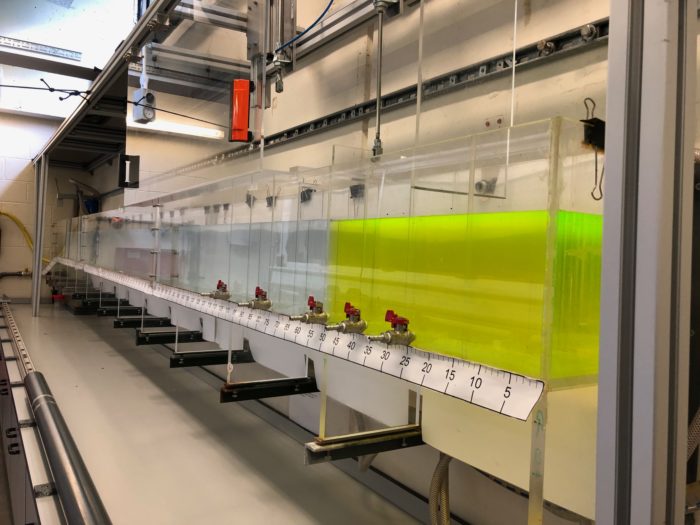
- The main section of the flume is approximately 2 x 5 x 0.25 m (width x length x depth)
- The lock system is flexible hosting up to 3 gates. The volume of each lock is variable by 0.125 m increments, up to a maximum length of 1 m.
- The gate(s) are lifted using pneumatic rams, the rate lift is variable. The timing of gate activation can be controlled electronically.
- Solute fluid is prepared in 200 litre mixing tank, this tank has both a rotary mixer and recirculation pump and low turbulence fluid transfer pump.
Pumped Density Current Tank
This is a ducted density current flume designed specifically to enable high resolution optical measurements within density currents, using both planar and tomographic PIV. The flume is designed to accommodate a range of refractive index matched fluids.
- The main section of the flume is approximately 1 x 2.5 x 0.2 m (width x length x depth), with an additional sump and air traps.
- The slope can be varied between 0-2°.
- The experimental area is ducted to remove the effect of surface waves.
- The tank is fed by a constant rate positive displacement gear pump. This pump is suitable for use with a range of refractive index matched fluids. The rate can be varied infinitely via an inverter.
- A pair of mixing tanks enable the preparation of refractive index matched fluids
Thin Recirculating Flume
This is primarily a teaching flume used to demonstrate bedform growth and development in unidirectional flow.
- The main section of the flume is approximately 05 x 1.5 x 0.2 m (width x length x depth).
- The channel can be tilted up to ~ 3° slope.
- The tank is recirculated by a variable speed stainless steel pump. The rate can vary infinitely via an inverter.
- This flow can recirculate water and sediment either directly or via a stilling tank.
- PIV (either laser or LED illuminated) can be used with this flume for high resolution bedform measurements.
Decagonal Tank
This is a settling tank designed to enable the deployment of the tomographic PIV system. The tank is designed to enable LED illumination with optical access for four cameras or MiniShaker.
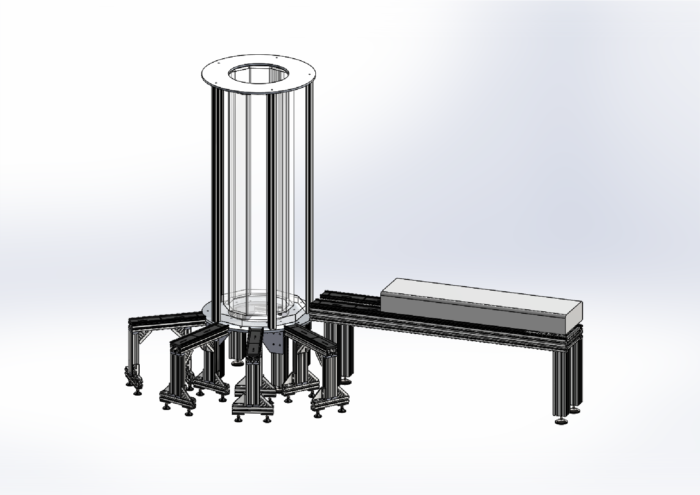
- Integrated mounts for four cameras and LED illumination
- Remote control system for releasing particles for settling studies.
- Tank designed to accommodate 2-layer PIV targets, as required by tomographic PIV.
- Integrated recirculation and system to suspend seeding material. Filter system allows rapid fluid replacement whilst capturing seeding materials
T-Tank
This is a T-shaped deep flume primarily designed to investigate density currents, both solute and particulate. This flume offers excellent visualisation and can be adapted with a wide range of inserts to change the experimental geometry. Input and output pumps are designed to balance, thus maintaining a constant water depth during experiments.
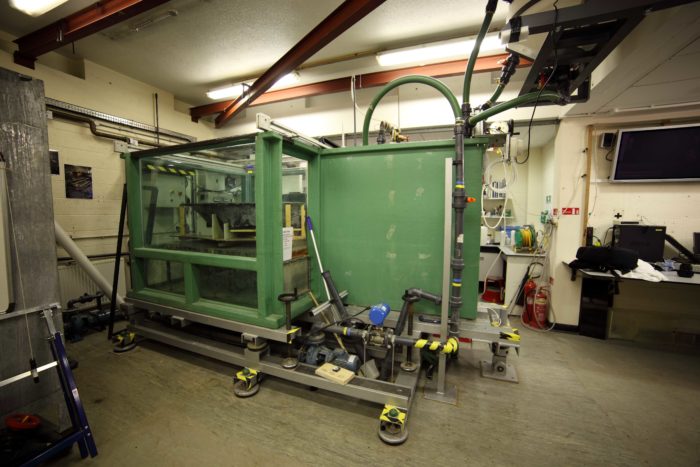
- The main experimental section of the T-tank is approximately 8 x 1.8 x 1.5 m (width x length x depth), and the input channel has a length of ~1.2 m.
- The experimental surface is 1.5 m2, raised to generate a sump space that is approximately 0.45 m above the bottom of the tank.
- The entire tank can be tilted up to 3° and the input channel slope can also be raised independently up to 3°.
- The tank is supplied by a pair of 1800 litre mixer tanks, yielding a maximum dense fluid volume of 3600 litres, although an experiment typically uses ~200-500 litres. The mixers can suspend sediment up to 200 µm and a maximum concentration of 10%.
- The dense fluid is pumped in via a bronze centrifugal pump with a maximum flow rate of ~7 l/s, the rate is monitored by an electromagnetic flowmeter.
- The tank output is pumped via a second bronze centrifugal pump with a maximum flow rate of ~7 l/s, the rate is monitored by an electromagnetic flowmeter.
- There is a 200 litre header tank and mixer that can suspend sediments up to ~ 200 µm this can be fed from the mixers to maintain a constant gravity controlled flow rate this feed, the absolute rate can be varied between 0.1-5 l/s and is also monitored via an electromagnetic flowmeter.
- A computer controlled X-Y traverse system that can be used with a range of depth tools to provide bathymetry measurements.
Re-circulating Flume
This a classic open channel recirculating flume that can recirculate water or clay suspensions. This flume is suitable of a wide range of applications including classic bedform experiments with a mobile bed, high concentration bedform experiments and wide range of open channel configurations. The flume offers good visualisation of both fluid flow and bedform development.

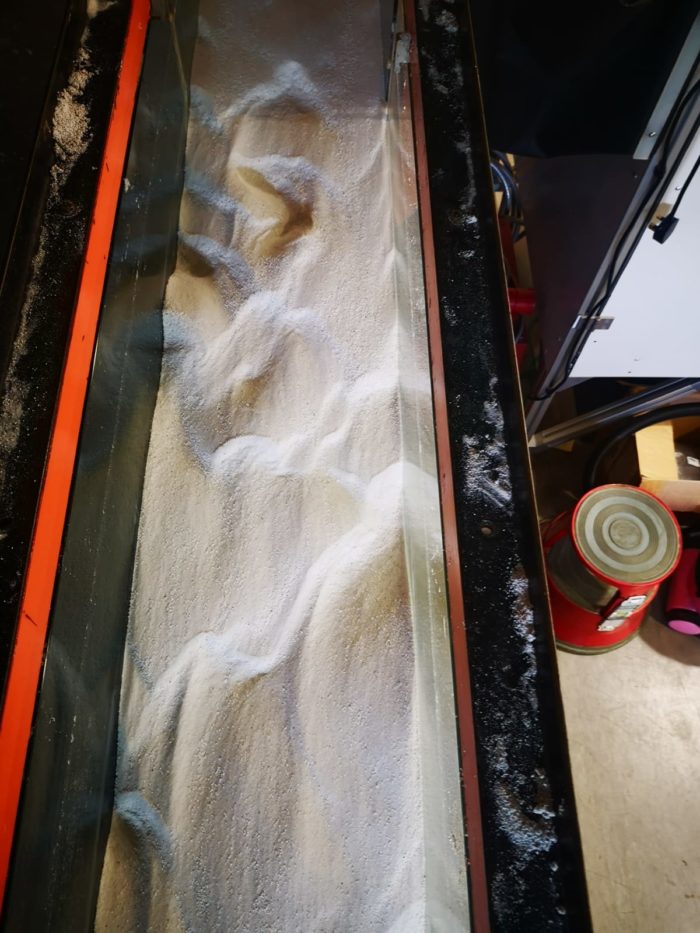
- The main section of the flume is approximately 3 x 8.5 x 0.3 m (width x length x depth) with a maximum fill depth of 0.275 m.
- The channel can be tilted up to ~ 1° slop
- The channel is recirculated by an open impeller Hidrostal pump with a maximum flow rate of 100 l/s. The rate can varied infinitely via a Danfoss inverter. This pump can recirculate clean water and sediment suspensions up to 50% volume (Kaolin).
- The flow rate can be monitored by an electromagnetic flowmeter.
- The pump has a high level – low level protection circuit which automatically stops the pump if the water level rises or falls. This makes this flume suitable for long duration unattended experiments.
- The tank also has a X-Y computer controlled traverse system (4 m length) that can be used with a range of depth tools to provide bathymetry measurements with both clear water and high concentration flows.
Large Scale Density Current Tank
The Large Scale Density Current Tank is designed to host large scale experiments either stream table type fluvial experiments or large-scale expanding density currents.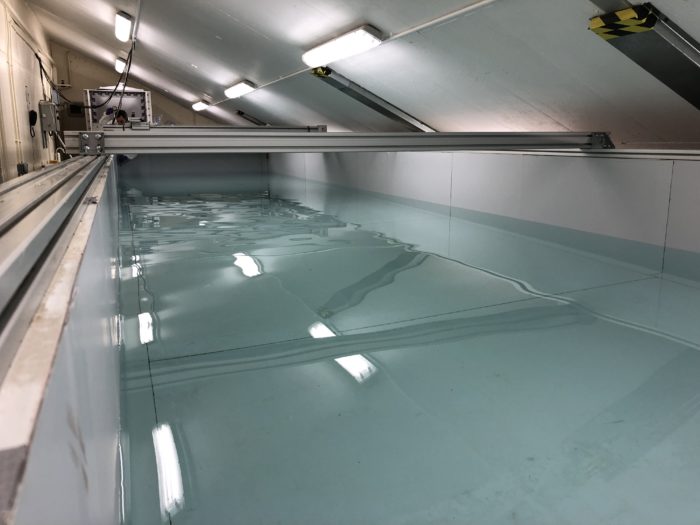
- The main section of the flume is approximately 2.5 x 10 x 1 m (width x length x depth).
- The tank is supplied by a 2000 litre mixer tank, with a variable speed paddle mixer.
- The dense fluid is pumped in via a stainless steel centrifugal pump with a maximum flow rate of ~14 l/s, the rate is monitored by an electromagnetic flowmeter. The input geometry is designed to flexible allows relocation of the input source.
- This tank can also be set-up to recirculate water and fine sediment from the output end to input via a pair of 1000 litre settling/stilling tanks.
- The tank has a 2.5 by 2.5 m computer controlled X-Y traverse system.
Work with us
If you'd like more information, please get in touch with Dr Gareth Keevil at g.m.keevil@leeds.ac.uk
